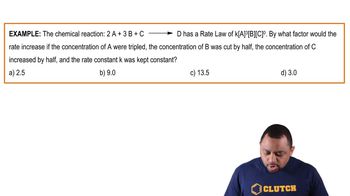Consider the reaction: NH4HS(s) ⇌ NH3(g) + H2S(g) At a certain temperature, Kc = 8.5⨉10-3. A reaction mixture at this temperature containing solid NH4HS has [NH3] = 0.166 M and [H2S] = 0.166 M. Will more of the solid form or will some of the existing solid decompose as equilibrium is reached?
Ch.15 - Chemical Equilibrium

Chapter 15, Problem 51
Consider the reaction and the associated equilibrium constant: aA(g) ⇌ bB(g) Kc = 4.0 Find the equilibrium concentrations of A and B for each value of a and b. Assume that the initial concentration of A in each case is 1.0 M and that no B is present at the beginning of the reaction. c. a=1;b=2
 Verified step by step guidance
Verified step by step guidance1
Step 1: Write down the equilibrium expression for the reaction. For the reaction aA(g) ⇌ bB(g), the equilibrium constant expression is Kc = [B]^b / [A]^a. In this case, a=1 and b=2, so the expression becomes Kc = [B]^2 / [A].
Step 2: Set up an ICE (Initial, Change, Equilibrium) table to keep track of the changes in concentrations of A and B. Initially, [A] = 1.0 M and [B] = 0. At equilibrium, [A] = 1.0 - x and [B] = 2x, where x is the change in concentration of A that reacts.
Step 3: Substitute the equilibrium concentrations into the equilibrium expression. This gives 4.0 = (2x)^2 / (1.0 - x).
Step 4: Solve the resulting equation for x. This will give you the change in concentration of A and, since the stoichiometry of the reaction is 1:2, twice this value will be the equilibrium concentration of B.
Step 5: Substitute the value of x back into the expressions for the equilibrium concentrations of A and B to find their actual values at equilibrium.

Verified video answer for a similar problem:
This video solution was recommended by our tutors as helpful for the problem above.
Was this helpful?
Key Concepts
Here are the essential concepts you must grasp in order to answer the question correctly.
Equilibrium Constant (Kc)
The equilibrium constant, Kc, is a numerical value that expresses the ratio of the concentrations of products to reactants at equilibrium for a given reaction at a specific temperature. It is calculated using the formula Kc = [B]^b / [A]^a, where [B] and [A] are the equilibrium concentrations of the products and reactants, respectively. A Kc value greater than 1 indicates that products are favored at equilibrium.
Recommended video:
Guided course

Equilibrium Constant Expressions
Initial Concentration and Changes at Equilibrium
In chemical reactions, the initial concentration of reactants and products influences the equilibrium position. For the reaction aA(g) ⇌ bB(g), if the initial concentration of A is 1.0 M and no B is present, the change in concentration as the system reaches equilibrium must be calculated. This involves determining how much A is converted to B based on the stoichiometric coefficients a and b.
Recommended video:
Guided course

Concentration Changes and Rate Law Example
Stoichiometry in Reactions
Stoichiometry refers to the quantitative relationship between reactants and products in a chemical reaction, defined by their coefficients in the balanced equation. In the context of the given reaction, the coefficients a and b indicate the molar ratios in which A and B react and are produced. Understanding stoichiometry is essential for calculating the changes in concentrations of A and B as the system reaches equilibrium.
Recommended video:
Guided course

Stoichiometry Concept
Related Practice
Textbook Question
Textbook Question
Silver sulfate dissolves in water according to the reaction: Ag2SO4(s) ⇌ 2 Ag+(aq) + SO42-(aq) Kc = 1.1⨉10-5 at 298 K. A 1.5-L solution contains 6.55 g of dissolved silver sulfate. If additional solid silver sulfate is added to the solution, will it dissolve?
Textbook Question
For the reaction shown here, Kc = 0.513 at 500 K. N2O4(g) ⇌ 2 NO2(g) If a reaction vessel initially contains an N2O4 concentration of 0.0500 M at 500 K, what are the equilibrium concentrations of N2O4 and NO2 at 500 K?
1
views
Textbook Question
For the reaction shown here, Kc = 255 at 1000 K. CO(g) + Cl2(g) ⇌ COCl2(g) If a reaction mixture initially contains a CO concentration of 0.1500 M and a Cl2 concentration of 0.175 M at 1000 K, what are the equilibrium concentrations of CO, Cl2, and COCl2 at 1000 K?
2
views
